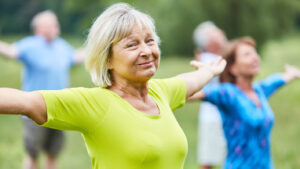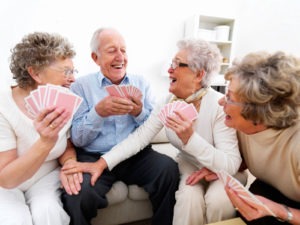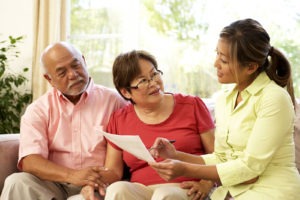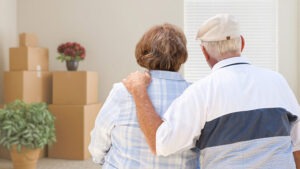How do you know if you’re aging optimally? J Kele Murdin, an award-winning, nationally recognized physical therapist, joins Suzanne Newman on the Answers for Elders Radio Show to talk about how to tell if you are aging optimally.
Kele says, “I think this is such a common question for older adults. On the physical therapy world, we have a lot of tools to measure things. So if I wanted to look at your posture, I could ask you to stand against the wall. Can you get your head against the wall with your heels, against the wall and your bottom in your head? You should be able to touch. Do you have an extension in your upper back? Touch your head. And if you can’t, that puts you at risk for fractures in your spine. That there are all these tools and measures we can do as a physical therapist that can measure posture, flexibility, endurance, things like that.”
Suzanne says, “I invested this year in an Apple Watch, one of the best things I ever did, because, how often does it say it’s time to get up? Because I get wrapped up in my work, or I’m sitting too long, and I find if I’m sitting too long, I stand up and I’m not moving as well. I’m not doing it as well. If it says it’s time to stand, I don’t care what I’m doing, even if I’m watching a movie, I can press pause, get up and walk around the house, and then come back and sit down. It’s that awareness piece. We’re passionate about the work that we do and we don’t realize two hours or whatever [have passed]. And so little devices like these watches are so helpful.”
Kele adds, “How much activity do we need to be doing to keep it running smoothly? Well, at least 30 minutes, five days a week of moderate exercise. So when we talk about aerobic exercise, it’s like a six out of ten on the scale. You should be able to talk, but it should take some effort. You wouldn’t be able to sing at that effort level. I think that level of intensity is what’s missed. You know, my aunt takes her dog out, who’s thought to go to the bathroom 15 times in her 15 minute walk. And that’s not hard enough. That’s not enough to get her heart to get stronger. It should feel like exercise and it should be intentional exercise. Subtle things, like how long, how hard, I think really makes a difference in people’s awareness and understanding of what optimal aging could look like.”
Suzanne asks, “What if somebody has arthritis, and can’t necessarily get up and walk fast [for exercise]?
Kele answers, “So, walking is too much weight-bearing. What can we do that can get my heart going that isn’t going to stress my joints as much? The first thing comes to mind is the pool. Do you have access to a pool? It takes a lot of the weight bearing off. Then what about a non-weight-bearing activity? Biking, recumbent bike, the gym, something like that, or a little step machine, when you’re sitting down, or an elliptical device. I came come up with ideas on how can I take out the joint pain… So that’s how the teamwork works together. We find what you like, because it needs to be something that you enjoy because you get to do it a lot.”
Kele specializes in fall prevention and caring for older adults. She is the founder of Murdin Therapy LLC and Group Otago. Reach her at Murdin Therapy or call 425-306-0502. Groupotago.com offers group fall prevention exercise programs and has a ton of information.
Check out our affiliate podcast Alzheimer’s Speaks.









